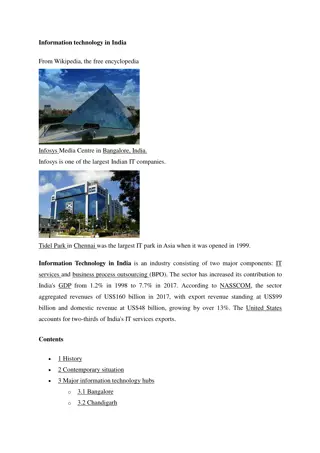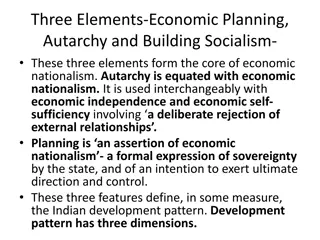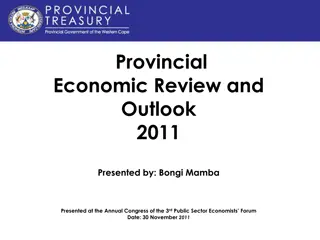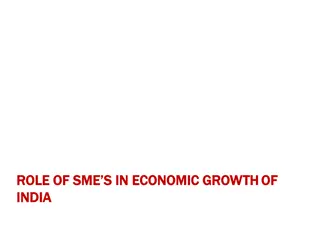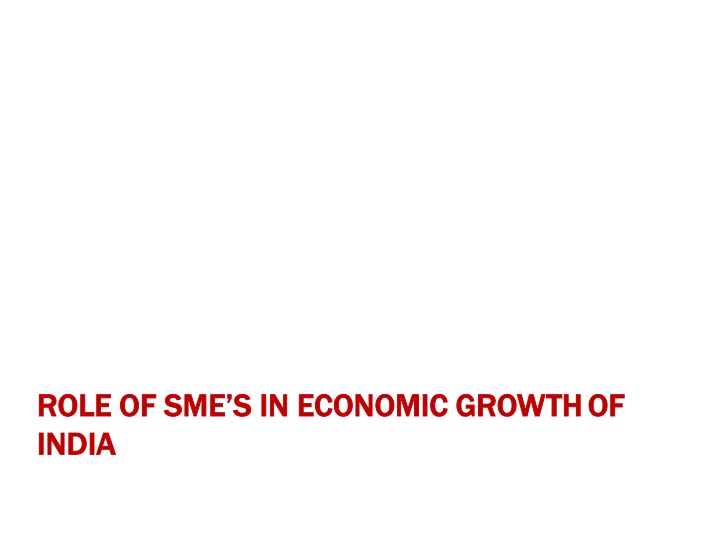
Role of SMEs in India's Economic Growth
Small and medium enterprises (SMEs) play a crucial role in India's economic development by contributing to domestic production, export earnings, employment generation, and foreign exchange earnings. This article discusses the significance of SMEs for industrial development, their impact on economic growth, and the MSME sector's definitions in India.
Download Presentation

Please find below an Image/Link to download the presentation.
The content on the website is provided AS IS for your information and personal use only. It may not be sold, licensed, or shared on other websites without obtaining consent from the author. If you encounter any issues during the download, it is possible that the publisher has removed the file from their server.
You are allowed to download the files provided on this website for personal or commercial use, subject to the condition that they are used lawfully. All files are the property of their respective owners.
The content on the website is provided AS IS for your information and personal use only. It may not be sold, licensed, or shared on other websites without obtaining consent from the author.
E N D
Presentation Transcript
ROLE OF ROLE OF SME S INDIA INDIA SME S IN ECONOMIC IN ECONOMIC GROWTH GROWTHOF OF
INTRODUCTION Small and medium enterprises are the backbone of industrial development. It is very important for both developed and developing country Small and medium enterprises always represented the model of economic development, which emphasized high contribution to domestic production, significant export earnings, low investment requirements, employment generation, effective contribution to foreign exchange earning of the nation with low import-intensive operations. The development of this sector came about primarily due to the vision of our late Prime Minister Jawaharlal Nehru who sought to develop core industry and have a supporting sector in the form of small scale enterprises.
INTRODUCTION.. SMEs sector has emerged as a dynamic and vibrant sector of the economy. The Indian economy is expected to grow by over 8 per cent per annum until 2020 and can become the second largest in the world, ahead of the United States, by 2050, and the thirdlargest after China and the United States by2032.
DEFINITION OF MSME According to new THE MICRO, SMALL AND MEDIUM ENTERPRISES DEVELOPMENT ACT, 2006 the MSME Definitions are as follows: In the case of the enterprises engaged in the manufacture or production of goods pertaining to any industry specified in the first schedule to the Industries ( Development and Regulation) Act, 1951, as
DEFINITION OF MSME FOR MANUFACTURING SECTOR Manufacturing Sector Enterprises Investment in plant & machinery Micro Enterprises Does not exceed twenty five lakh rupees Small Enterprises More than twenty five lakh rupees butdoes not exceed five crore rupees Medium Enterprises More than five crore rupees but does not exceed ten crore rupees
DEFINITION OF MSME FOR SERVICESECTOR Service Sector Enterprises Micro Enterprises Small Enterprises Investment in plant & machinery Does not exceed ten lakh rupees: More than ten lakh rupees but does not exceed two crore rupees More than two crore rupees but does not exceed five core rupees Medium Enterprises
SUPPORTING AGENCIES OF SMES Some of the important organizations that are associated with SMEs in India are: Small Industries Development Organization (SIDO), National Small Industries Corporation Ltd. (NSIC), Small Industries Development Bank of India (SIDBI), Confederation of IndianIndustry (CII), Laghu Udyog Bharti (LUB), Federation of Indian Chamber of Commerce and Industry (FICCI), Associated Chamber ofCommerce and Industry of India (ASSOCHAM), National Institute of Small- Industry Extension Training (NISIET), World Association for Small and Medium Enterprises (WASME), Small Scale Industries Board (SSIB), PHD Chamber of Commerce and Industry (PHDCCI), Federation of Indian Exporters Organization (FIEO), Federation of Associations of Small Industries of India (FASII)
ROLE OF SMES IN INDIANECONOMY In order understand the impact of SMEs on the Indian economy;one must study the trend and pattern that have been prevalent in the preceding years. It gives us the vivid picture of what followsnext. Following graphics help us to understand the present scenarioand their contributions of MSMEs in India.
GROWTH PERFORMANCE OF SMES ORMSMES IN INDIA
THE OPPORTUNITIES OF GROWTH IN THESMES SECTOR 1. Less Capital Intensive 2. Extensive Promotion & Support by Government 3. Reservation for Exclusive Manufacture by small scale sector 4. Project Profiles 5. Funding - Finance & Subsidies 6. Machinery Procurement 7. Raw Material Procurement 8. Manpower Training 9. Technical & Managerial skills 10. Tooling & Testing support 11. Reservation for Exclusive Purchase by Government 12. Export Promotion 13. Growth in demand in the domestic market size due to overall economic growth 14. Increasing Export Potential for Indian products
FACTORS AFFECTINGSMES MSMEs in India face several problems such as- lack of availability of adequate and timely credit High cost of credit inadequate infrastructure facilities like power, water and roads, and lack of access to modern technology. limited access to equity capital problems in supply to government departments and agencies procurement of raw materials at a competitive price Issues of storage Designing, packaging and product display 1. 2. 3. 4. 5. 6. 7. 8.
CONCLUSION In India SMEs has achieved steady growth over the last couple of years. The role of SMEs in the industrial sector is growing rapidly and they have become a thrust area for future growth. The Indian market is growing and the Indian industry is making rapid progress in various Industries like manufacturing, food processing, textile and garments, retail, precision engineering, information technology, pharmaceuticals, agro and service sectors. Under the changing economic scenario the SMEs have both the opportunities and challenges before them.





